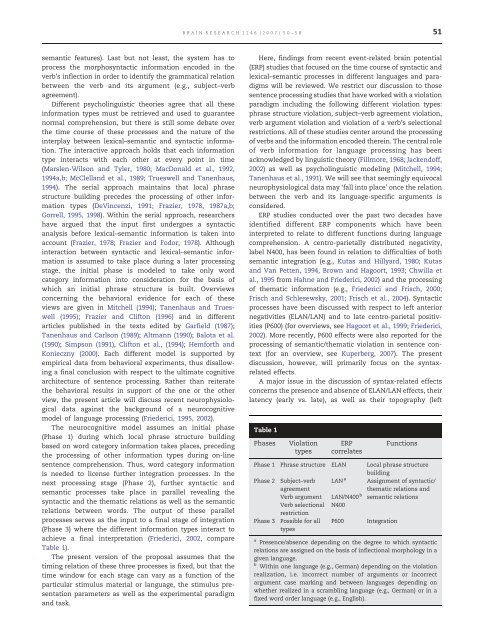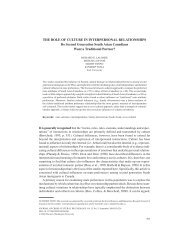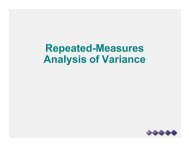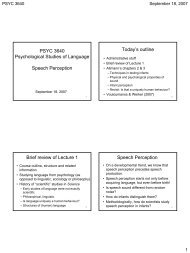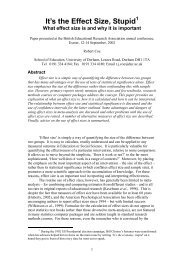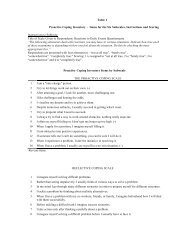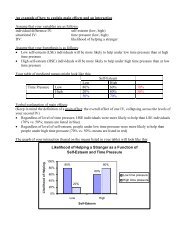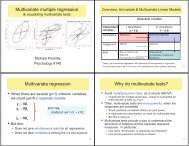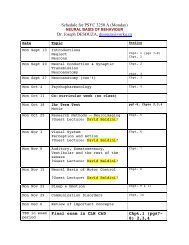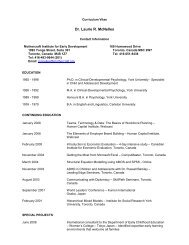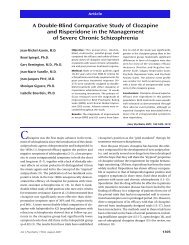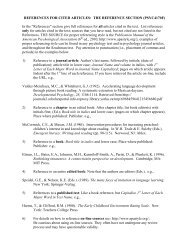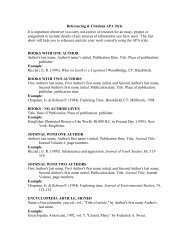Mapping sentence form onto meaning: The syntax–semantic interface
Mapping sentence form onto meaning: The syntax–semantic interface
Mapping sentence form onto meaning: The syntax–semantic interface
Create successful ePaper yourself
Turn your PDF publications into a flip-book with our unique Google optimized e-Paper software.
semantic features). Last but not least, the system has to<br />
process the morphosyntactic in<strong>form</strong>ation encoded in the<br />
verb’s inflection in order to identify the grammatical relation<br />
between the verb and its argument (e.g., subject–verb<br />
agreement).<br />
Different psycholinguistic theories agree that all these<br />
in<strong>form</strong>ation types must be retrieved and used to guarantee<br />
normal comprehension, but there is still some debate over<br />
the time course of these processes and the nature of the<br />
interplay between lexical–semantic and syntactic in<strong>form</strong>ation.<br />
<strong>The</strong> interactive approach holds that each in<strong>form</strong>ation<br />
type interacts with each other at every point in time<br />
(Marslen-Wilson and Tyler, 1980; MacDonald et al., 1992,<br />
1994a,b; McClelland et al., 1989; Trueswell and Tanenhaus,<br />
1994). <strong>The</strong> serial approach maintains that local phrase<br />
structure building precedes the processing of other in<strong>form</strong>ation<br />
types (DeVincenzi, 1991; Frazier, 1978, 1987a,b;<br />
Gorrell, 1995, 1998). Within the serial approach, researchers<br />
have argued that the input first undergoes a syntactic<br />
analysis before lexical–semantic in<strong>form</strong>ation is taken into<br />
account (Frazier, 1978; Frazier and Fodor, 1978). Although<br />
interaction between syntactic and lexical–semantic in<strong>form</strong>ation<br />
is assumed to take place during a later processing<br />
stage, the initial phase is modeled to take only word<br />
category in<strong>form</strong>ation into consideration for the basis of<br />
which an initial phrase structure is built. Overviews<br />
concerning the behavioral evidence for each of these<br />
views are given in Mitchell (1994); Tanenhaus and Trueswell<br />
(1995); Frazier and Clifton (1996) and in different<br />
articles published in the texts edited by Garfield (1987);<br />
Tanenhaus and Carlson (1989); Altmann (1990); Balota et al.<br />
(1990); Simpson (1991), Clifton et al., (1994); Hemforth and<br />
Konieczny (2000). Each different model is supported by<br />
empirical data from behavioral experiments, thus disallowing<br />
a final conclusion with respect to the ultimate cognitive<br />
architecture of <strong>sentence</strong> processing. Rather than reiterate<br />
the behavioral results in support of the one or the other<br />
view, the present article will discuss recent neurophysiological<br />
data against the background of a neurocognitive<br />
model of language processing (Friederici, 1995, 2002).<br />
<strong>The</strong> neurocognitive model assumes an initial phase<br />
(Phase 1) during which local phrase structure building<br />
based on word category in<strong>form</strong>ation takes places, preceding<br />
the processing of other in<strong>form</strong>ation types during on-line<br />
<strong>sentence</strong> comprehension. Thus, word category in<strong>form</strong>ation<br />
is needed to license further integration processes. In the<br />
next processing stage (Phase 2), further syntactic and<br />
semantic processes take place in parallel revealing the<br />
syntactic and the thematic relations as well as the semantic<br />
relations between words. <strong>The</strong> output of these parallel<br />
processes serves as the input to a final stage of integration<br />
(Phase 3) where the different in<strong>form</strong>ation types interact to<br />
achieve a final interpretation (Friederici, 2002, compare<br />
Table 1).<br />
<strong>The</strong> present version of the proposal assumes that the<br />
timing relation of these three processes is fixed, but that the<br />
time window for each stage can vary as a function of the<br />
particular stimulus material or language, the stimulus presentation<br />
parameters as well as the experimental paradigm<br />
and task.<br />
B R A I N R E S E A R C H 1 1 4 6 ( 2 0 0 7 ) 5 0 – 5 8<br />
Here, findings from recent event-related brain potential<br />
(ERP) studies that focused on the time course of syntactic and<br />
lexical–semantic processes in different languages and paradigms<br />
will be reviewed. We restrict our discussion to those<br />
<strong>sentence</strong> processing studies that have worked with a violation<br />
paradigm including the following different violation types:<br />
phrase structure violation, subject–verb agreement violation,<br />
verb argument violation and violation of a verb’s selectional<br />
restrictions. All of these studies center around the processing<br />
of verbs and the in<strong>form</strong>ation encoded therein. <strong>The</strong> central role<br />
of verb in<strong>form</strong>ation for language processing has been<br />
acknowledged by linguistic theory (Fillmore, 1968; Jackendoff,<br />
2002) as well as psycholinguistic modeling (Mitchell, 1994;<br />
Tanenhaus et al., 1991). We will see that seemingly equivocal<br />
neurophysiological data may ‘fall into place’ once the relation<br />
between the verb and its language-specific arguments is<br />
considered.<br />
ERP studies conducted over the past two decades have<br />
identified different ERP components which have been<br />
interpreted to relate to different functions during language<br />
comprehension. A centro-parietally distributed negativity,<br />
label N400, has been found in relation to difficulties of both<br />
semantic integration (e.g., Kutas and Hillyard, 1980; Kutas<br />
and Van Petten, 1994, Brown and Hagoort, 1993; Chwilla et<br />
al., 1995 from Hahne and Friederici, 2002) and the processing<br />
of thematic in<strong>form</strong>ation (e.g., Friederici and Frisch, 2000;<br />
Frisch and Schlesewsky, 2001; Frisch et al., 2004). Syntactic<br />
processes have been discussed with respect to left anterior<br />
negativities (ELAN/LAN) and to late centro-parietal positivities<br />
(P600) (for overviews, see Hagoort et al., 1999; Friederici,<br />
2002). More recently, P600 effects were also reported for the<br />
processing of semantic/thematic violation in <strong>sentence</strong> context<br />
(for an overview, see Kuperberg, 2007). <strong>The</strong> present<br />
discussion, however, will primarily focus on the syntaxrelated<br />
effects.<br />
A major issue in the discussion of syntax-related effects<br />
concerns the presence and absence of ELAN/LAN effects, their<br />
latency (early vs. late), as well as their topography (left<br />
Table 1<br />
Phases Violation<br />
types<br />
ERP<br />
correlates<br />
Functions<br />
Phase 1 Phrase structure ELAN Local phrase structure<br />
building<br />
Phase 2 Subject–verb<br />
agreement<br />
Verb argument LAN/N400 b<br />
Verb selectional<br />
restriction<br />
Phase 3 Possible for all<br />
types<br />
LAN a<br />
N400<br />
P600 Integration<br />
Assignment of syntactic/<br />
thematic relations and<br />
semantic relations<br />
a Presence/absence depending on the degree to which syntactic<br />
relations are assigned on the basis of inflectional morphology in a<br />
given language.<br />
b Within one language (e.g., German) depending on the violation<br />
realization, i.e. incorrect number of arguments or incorrect<br />
argument case marking and between languages depending on<br />
whether realized in a scrambling language (e.g., German) or in a<br />
fixed word order language (e.g., English).<br />
51


